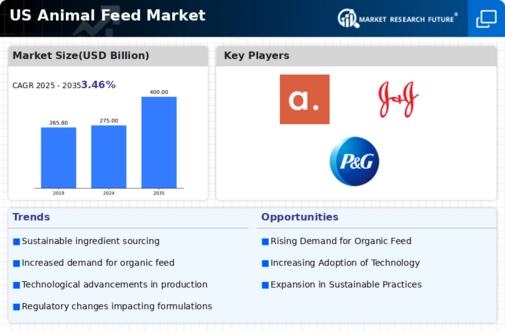Increasing Livestock Population
The growth in livestock population in the United States is a crucial driver for the animal feed market. As farmers expand their operations to meet rising consumer demand, the need for animal feed escalates. In 2025, the total livestock population is projected to exceed 100 million head, necessitating a substantial supply of feed. This increase presents opportunities for feed manufacturers to develop specialized products tailored to different species and production stages. Moreover, the expansion of livestock farming operations is likely to stimulate investments in the animal feed market, fostering innovation and competition among producers.
Rising Demand for Animal Protein
The increasing consumer preference for animal protein in the United States is a primary driver of the animal feed market. As the population grows, the demand for meat, dairy, and eggs rises, leading to a corresponding increase in the need for animal feed. In 2025, the meat consumption in the US is projected to reach approximately 100 million metric tons, necessitating a robust supply of quality feed. This trend indicates that the animal feed market must adapt to meet the nutritional requirements of livestock, ensuring optimal growth and production. Furthermore, the shift towards higher-quality animal products compels feed manufacturers to innovate and enhance their offerings, thereby stimulating growth within the animal feed market.
Regulatory Changes and Compliance
Regulatory frameworks governing the animal feed market are evolving, impacting production practices and ingredient sourcing. Stricter regulations regarding feed safety and quality are prompting manufacturers to enhance their compliance measures. In 2025, it is anticipated that compliance costs could rise by 15%, influencing pricing strategies within the market. This regulatory landscape encourages companies to invest in research and development to ensure their products meet the required standards. Consequently, businesses that proactively adapt to these changes are likely to strengthen their market position, thereby driving growth in the animal feed market.
Shift Towards Sustainable Practices
Sustainability has become a focal point in the animal feed market, driven by both consumer demand and regulatory pressures. The push for environmentally friendly practices is prompting feed manufacturers to explore alternative ingredients, such as plant-based proteins and by-products. In 2025, it is estimated that sustainable feed solutions could capture up to 30% of the market share, reflecting a significant shift in production methodologies. This transition not only addresses environmental concerns but also aligns with consumer preferences for ethically sourced animal products. As a result, companies that prioritize sustainability in their feed formulations are likely to gain a competitive edge in the animal feed market.
Technological Innovations in Feed Production
Technological advancements are reshaping the animal feed market, enhancing efficiency and product quality. Innovations such as precision nutrition, which tailors feed formulations to the specific needs of animals, are gaining traction. In 2025, the adoption of smart feeding technologies is expected to increase by 25%, allowing for better monitoring and management of livestock diets. These technologies not only improve feed conversion rates but also reduce waste, contributing to more sustainable practices. As the industry embraces these innovations, the animal feed market is likely to experience significant growth, driven by the demand for more effective and efficient feeding solutions.














Leave a Comment